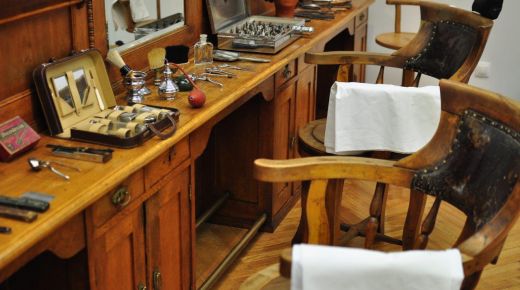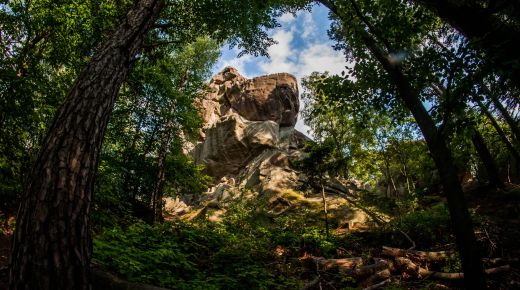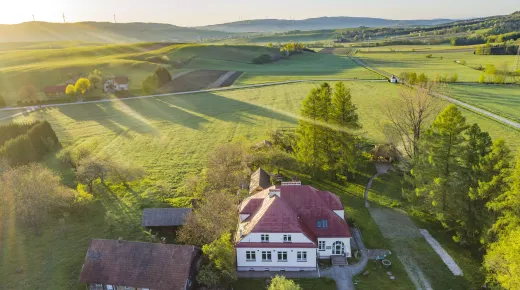However, it is not just the architectural beauty that draws people to this place. The exhibitions showcase the history of the monument and the wartime operations fought in the Low Beskids, particularly the largest battle ever fought in the mountains of our country during World War II
Historical Museum in Dukla
Trakt Węgierski 5
38-450 Dukla
phone: 13 43 30 085
e-mail: muzeum@dukla.pl
HISTORY OF THE PALACE AND PARK COMPLEX – ONE OF THE LOW BESKIDS’ ATTRACTIONS
Nestled in the greenery and mountains of the Low Beskids, the palace dates back to the 16th century. Its construction was initiated by Jan Jordan. Over the centuries, the palace evolved, and thanks to Franciszek Bernard Mniszech, it was transformed into a structure in the style of an Italian palazzo in fortezza. Later, Jerzy August Wandalin Mniszech enhanced its splendor, expanding it and surrounding it with a magnificent park inspired by French gardens. During this period, the Palace in Dukla was one of the most beautiful residences not only in the Low Beskids but in the entire country. Its interiors were filled with works of art, it housed a court theater, and its architecture was awe-inspiring.
Over the years, the palace changed hands—from the Ossoliński family to the Stadnicki, Męciński, and Tarnowski families. The devastation of World War II and the many conflicts that plagued the Low Beskids led to the confiscation of the Dukla estate from its rightful owners. Despite numerous attempts to reclaim the monument, it wasn’t until 2012 that this was achieved.
THE DEVELOPMENT OF THE HISTORICAL MUSEUM IN THE LOW BESKIDS
The museum in Dukla began operations in 1964 with an exhibition commemorating the 20th anniversary of the Battle of Dukla, presenting the Carpathian-Dukla Operation—a battle fought on the lands of the Low Beskids. The idea was conceived by members of the PTTK (Polish Tourist and Sightseeing Society) from Krosno, Rzeszów, and Dukla. They also proposed housing the museum in the palace of the Mniszech family. This initiative led to the renovation of the damaged monument. In 1968, the museum expanded from one room to three. In 1972, it was renamed the Museum of Brotherhood in Arms. Just three years later, the Low Beskids institution grew to include new buildings and part of the park. After their renovation, the exhibition space increased significantly. Following numerous changes, the museum was renamed the Historical Museum – Palace in Dukla in 1991. In 2012, after the Tarnowski family regained the monument, the museum became its tenant, continuing its operations and sharing the history of the battles fought in the Low Beskids.
WHAT AWAITS VISITORS INSIDE THIS LOW BESKIDS ATTRACTION
Within the palace walls, visitors can embark on a unique journey through time. A visit here offers a glimpse into the era when the residence in the Low Beskids was owned by the Mniszech family. Walking through the palace, one can feel like a guest of an aristocratic family. Two rooms of the monument feature original furnishings, and the library is filled with works from the palace collection. Complementing the experience are preserved decorative elements such as clocks, glassware, carpets, and tableware. Historical photographs, postcards of Dukla’s landscapes, and documents further illuminate the rich history of the town.
The second part of the exhibition takes visitors to the battlefields of the Low Beskids. The collections detail the history and course of the Carpathian and Gorlice-Tarnów operations of 1914–1915. Another section focuses on the Carpathian-Dukla Operation, the largest mountain battle of World War II. Most of the exhibits consist of weapons and equipment used by soldiers during these battles in the Carpathians, many of which were found on the battlefields of the Low Beskids.
Outside the palace, an impressive collection of heavy weaponry awaits visitors. Various types of artillery are displayed, including howitzers, anti-aircraft guns, field guns, and rocket launchers. This site is not only a must-see for history enthusiasts exploring the Low Beskids but also for those looking to enjoy the tranquility of the palace park, which invites leisurely strolls in its peaceful surroundings.
DUKLA IN THE LOW BESKIDS – OTHER PLACES TO SEE
This 14th-century town is sure to attract lovers of sacred architecture. Highlights include the Rococo-style Church of St. Mary Magdalene and the Bernardine Monastery and Church—Sanctuary of St. John of Dukla. This small town in the Low Beskids also boasts a well-preserved urban layout, particularly its market square with a neo-gothic town hall and historic tenement houses. To the south, the town is surrounded by greenery and mountains, a reminder that the wild nature of the Low Beskids is within easy reach. The most popular destination is Mount Cergowa, offering breathtaking views of the Low Beskids from its observation tower. From Dukla, the yellow trail leads there (4.5 km one way), passing the famous Golden Well. According to legend, this well marks the spot where St. John of Dukla began his hermit life. The same trail can be shortened by driving to the hamlet of Ciułówka, where a parking lot is available. Another site associated with the saint is the Hermitage of St. John of Dukla in Trzcinica. Dukla offers a blend of history, architecture, and wild nature, making it a must-visit destination in the Low Beskids.
READ MORE ABOUT HISTORICAL TOURISM AND MILITARY IN THE LOW BESKID
Places worth seeing nearby:
Ignacy Łukasiewicz Museum of Oil Industry in Bóbrka
Maria Konopnicka Museum in Żarnowiec
Private Museum of Podkarpackie Battlefields in Krosno
-
Bernardine church and monastery in Dukla
-
Town Hall from the late 17th/early 18th century in Dukla
-
Flora nature reserves – Yew trees in Nowa Wieś and Millennium Nature Reserve on Mount Cergowa
-
Franciscan Church with the chapel of the Oświęcim family in Krosno
Photo: Krzysztof Zajączkowski



